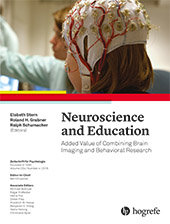Abstract
Abstract. Novel data collection methods and analysis algorithms developed in the field of neuroergonomics have opened new possibilities for research in education. Psychophysiological data can characterize the cognitive and emotional dimensions of engagement. This paper aims to describe the application of this research methodology to synchronously measure emotional and cognitive engagement during learning tasks.
References
(2014). At the very root of the development of interest: using human body contexts to improve women’s emotional engagement in introductory physics. European Journal of Physics Education, 5, 31–48. doi: 10.20308/ejpe.93516
(2004). Real-time analysis of EEG indexes of alertness, cognition, and memory acquired with a wireless EEG headset. International Journal of Human-Computer Interaction, 17, 151–170. doi: 10.1207/s15327590ijhc1702_3
(2012). Electrodermal activity. New York, NY: Springer.
(1994). Measuring emotion: The self-assessment manikin and the semantic differential. Journal of Behavior Therapy and Experimental Psychiatry, 25, 49–59. doi: 10.1016/0005-7916(94)90063-9
(2015). Assessing the multiple dimensions of engagement to characterize learning: A neurophysiological perspective. Journal of Visualized Experiments, 101, 1–8. doi: 10.3791/52627
(1998). Electroencephalographic and psychometric differences between boys with and without attention-deficit/hyperactivity disorder (ADHD): A pilot study. Applied Psychophysiology and Biofeedback Journal, 23, 179–188. doi: 10.1023/A:1022247405278
(1988). EEG measures of cerebral asymmetry: Conceptual and methodological issues. The International Journal of Neuroscience, 39, 7l–89. doi: 10.3109/00207458808985694
(2004). School engagement: Potential of the concept, state of the evidence. Review of Educational Research, 74, 59–109. doi: 10.3102/00346543074001059
(2004). An evaluation of an adaptive automation system using a cognitive vigilance task. Biological Psychology, 67, 283–297. doi: 10.1016/j.biopsycho.2004.01.002
(2014). Measuring software screen complexity: Relating eye tracking, emotional valence, and subjective ratings. International Journal of Human-Computer Interaction, 30, 518–532. doi: 10.1080/10447318.2014.906156
(2011). Drowsiness/alertness algorithm development and validation using synchronized EEG and cognitive performance to individualize a generalized model. Biological Psychology, 87, 241–250. doi: 10.1016/j.biopsycho.2011.03.003
(2014). Neurophysiological correlates of cognitive absorption in an enactive training context. Computers in Human Behavior, 34, 273–283. doi: 10.1016/j.chb.2014.02.011
(1991). Discourse on the development of EEG diagnostics and biofeedback for attention-deficit/hyperactivity disorders. Biofeedback and Self-Regulation, 16, 201–225. doi: 10.1007/BF01000016
(2002). The effects of a biocybernetic system on the vigilance decrement. Human Factors, 44, 654–664. doi: 10.1518/0018720024496944
(1995). Biocybernetic system evaluation indices of operator engagement in automated task. Biological Psychology, 40, 187–195. doi: 10.1016/0301-0511(95)05116-3
(2015). Consumers’ cognitive lock-in on websites: Evidence from a neurophysiological study. Journal of Internet Commerce, 14, 277–293. doi: 10.1080/15332861.2015.1028249
(1987). COMSTAT Rule for vigilance classification based on spontaneous EEG activity. Neuropsychobiology, 17, 105–117. doi: 10.1159/000118347
(2006). Instructional video in e-learning: Assessing the impact of interactive video on learning effectiveness. Information and Management, 43, 15–27. doi: 10.1016/j.im.2005.01.004



